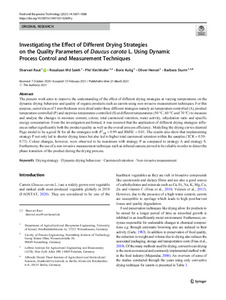| dc.date.accessioned | 2021-05-25T09:42:05Z | |
| dc.date.available | 2021-05-25T09:42:05Z | |
| dc.date.issued | 2021-03-21 | |
| dc.identifier | doi:10.17170/kobra-202105183914 | |
| dc.identifier.uri | http://hdl.handle.net/123456789/12846 | |
| dc.description.sponsorship | Gefördert im Rahmen des Projekts DEAL | ger |
| dc.language.iso | eng | eng |
| dc.rights | Namensnennung 4.0 International | * |
| dc.rights.uri | http://creativecommons.org/licenses/by/4.0/ | * |
| dc.subject | drying strategy | eng |
| dc.subject | dynamic drying behaviour | eng |
| dc.subject | carotenoid retention | eng |
| dc.subject | non-invasive measurement | eng |
| dc.subject.ddc | 580 | |
| dc.subject.ddc | 630 | |
| dc.title | Investigating the Effect of Different Drying Strategies on the Quality Parameters of Daucus carota L. Using Dynamic Process Control and Measurement Techniques | eng |
| dc.type | Aufsatz | |
| dcterms.abstract | The present work aims to improve the understanding of the effect of different drying strategies at varying temperatures on the dynamic drying behaviour and quality of organic products such as carrots using non-invasive measurement techniques. For this purpose, carrot slices of 3 mm thickness were dried under three different strategies namely air temperature controlled (A), product temperature controlled (P) and stepwise temperature controlled (S) at different temperatures (50 °C, 60 °C and 70 °C) to measure and analyse the changes in moisture content, colour, total carotenoid retention, water activity, rehydration ratio and specific energy consumption. From the investigation performed, it was incurred that the application of different drying strategies influences rather significantly both the product quality as well as the overall process efficiency. Modelling the drying curves deemed Page model to be a good fit for all the strategies with R2adj = 0.99 and RMSE = 0.01. The results also show that implementing strategy P not only led to shorter drying times but also led to higher total carotenoid retention within the samples (TCR = 0.59–0.73). Colour changes, however, were observed to be maximum with strategy P as compared to strategy A and strategy S. Furthermore, the use of a non-invasive measurement technique such as infrared camera proved to be reliable in order to detect the phase transition of the product during the drying process. | eng |
| dcterms.accessRights | open access | |
| dcterms.creator | Raut, Sharvari | |
| dcterms.creator | Md Saleh, Rosalizan Binti | |
| dcterms.creator | Kirchhofer, Phil | |
| dcterms.creator | Kulig, Boris | |
| dcterms.creator | Hensel, Oliver | |
| dcterms.creator | Sturm, Barbara | |
| dc.relation.doi | doi:10.1007/s11947-021-02609-y | |
| dc.subject.swd | Trocknung | ger |
| dc.subject.swd | Trocknungsverhalten | ger |
| dc.subject.swd | Karotte | ger |
| dc.subject.swd | Lebensmittelqualität | ger |
| dc.subject.swd | Messung | ger |
| dc.type.version | publishedVersion | |
| dcterms.source.identifier | eissn:1935-5149 | |
| dcterms.source.issue | Issue 6 | |
| dcterms.source.journal | Food and Bioprocess Technology | eng |
| dcterms.source.pageinfo | 1067-1088 | |
| dcterms.source.volume | Volume 14 | |
| kup.iskup | false | |


